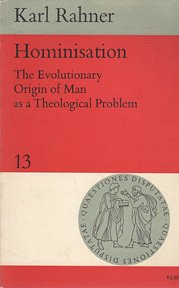120 pages
Published 1965 by Herder & Herder.

120 pages
Published 1965 by Herder & Herder.
Preface The Preface describes the limits within which the book must deal as it concentrates on the position of Catholic theology in regard to hominisation, the theory of man’s evolutionary origins. The central concern is the relation of the Catholic scientist and his/her findings to the official teaching of the Church. The Church’s toleration of a moderate theory of evolution leaves many questions unanswered and raises new ones. The book attempts a small advance toward some answers and a clearer recognition of what is still open to question. Section One
This section aims is to show clearly from the declarations of the Catholic Church what a Catholic scientist may or may not say as a Christian in the matter of evolution.
Section Two This section examines the reasons for the official teachings of the church presented in the previous section. These reasons are linked with what Scripture has to say …
Preface The Preface describes the limits within which the book must deal as it concentrates on the position of Catholic theology in regard to hominisation, the theory of man’s evolutionary origins. The central concern is the relation of the Catholic scientist and his/her findings to the official teaching of the Church. The Church’s toleration of a moderate theory of evolution leaves many questions unanswered and raises new ones. The book attempts a small advance toward some answers and a clearer recognition of what is still open to question. Section One
This section aims is to show clearly from the declarations of the Catholic Church what a Catholic scientist may or may not say as a Christian in the matter of evolution.
Section Two This section examines the reasons for the official teachings of the church presented in the previous section. These reasons are linked with what Scripture has to say about the origins of man that allow a neutral or even permissive attitude to modern evolutionary theory. The question is what is the source of the knowledge that the author of Genesis had of what he reports, or how was it known to the sources which he incorporated into his work under the light and protective guarantee of inspiration? Rahner’s answer is that he knew it as historical aetiology. The meaning of that term is presented at length as is its application to Genesis.
Section Three The third section, fifty percent longer than the first two together, considers several theological and philosophical questions raised by the relation between sacred theology and contemporary evolutionary theory, They include the distinction between spirit and matter, the unity of spirit and matter, the concepts of becoming, of cause and of operation, the creation of the spiritual soul, the insights of Aristotelian scholasticism, and the biblical narrative of man’s origin as it relates to the theory of evolution.